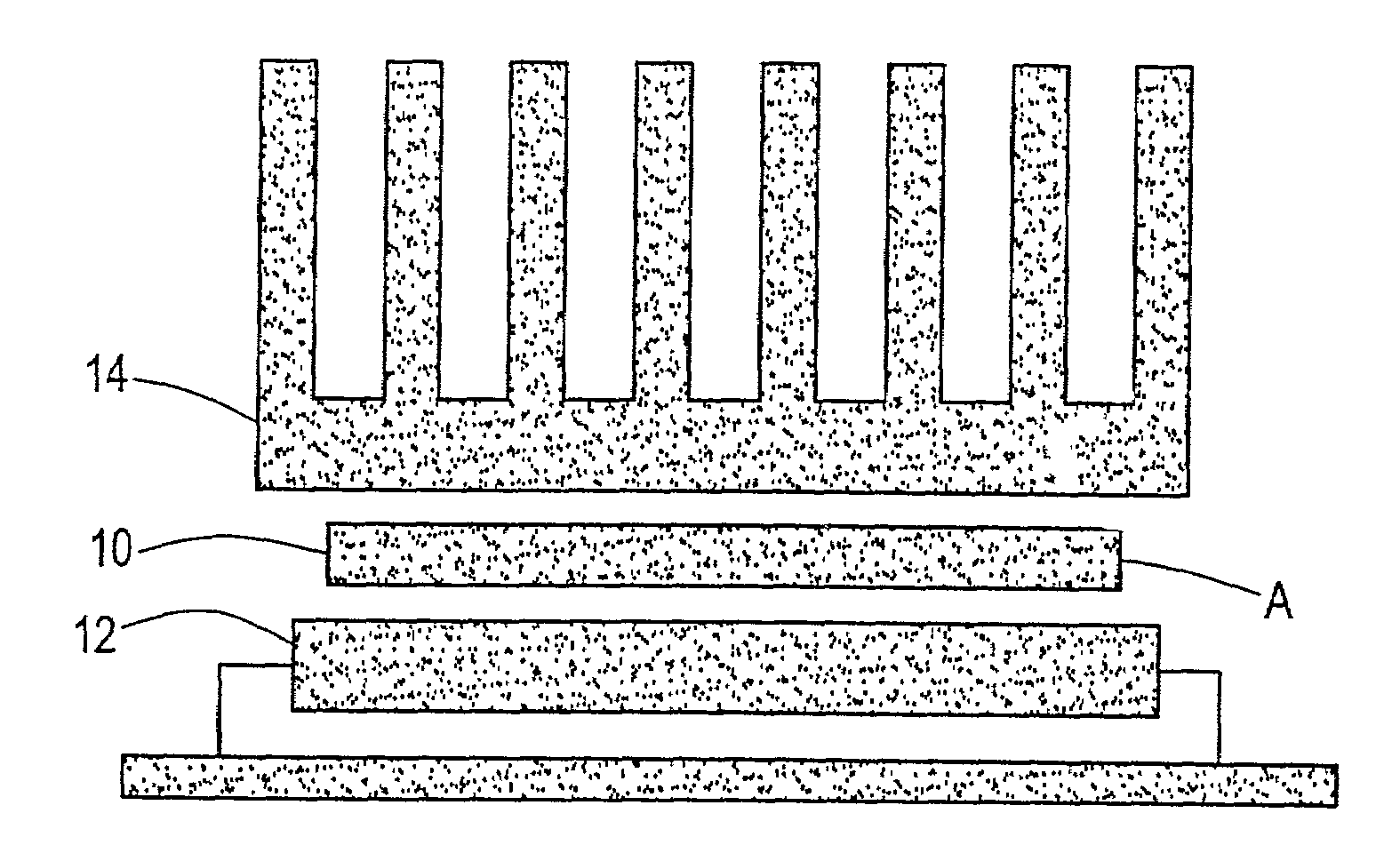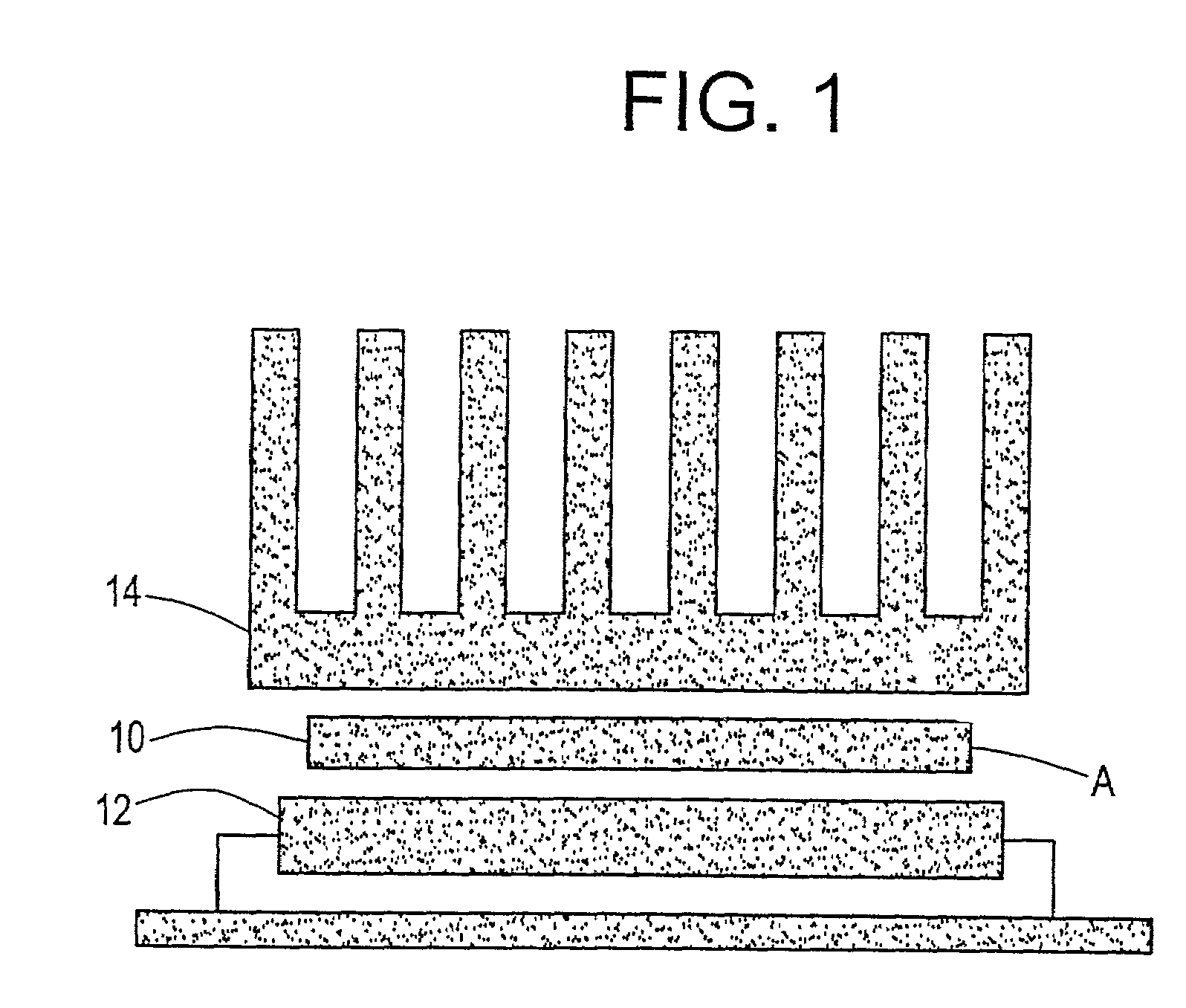Thermal interface material with low melting alloy
a technology of thermal interface material and low melting alloy, which is applied in the direction of instruments, investigating phase/state change, and electrical apparatus casings/cabinets/drawers, etc., can solve the problems of high manufacturing cost, large heat generation of power supply assemblies of such microprocessors, and extensive assembly process. , to achieve the effect of easy field service, equivalent thermal performance and convenient handling
- Summary
- Abstract
- Description
- Claims
- Application Information
AI Technical Summary
Benefits of technology
Problems solved by technology
Method used
Image
Examples
example 1
[0074
A thermal transfer composition was prepared by forming a matrix an incorporating an LMA into the matrix. The following components were melted together to form the matrix:
[0075]1 part by weight Kraton 1652
[0076]2 parts by weight Regalite
[0077]3 parts by weight Shellflex
[0078]0.05 parts by weight antioxidant.
[0079]The melted matrix was a clear fluid liquid which, if cooled, becomes a solid pressure sensitive adhesive. The polymer matrix was combined with an LMA in the ratio of 1 part by weight polymer matrix to 9 parts by weight LMA at a temperature above the melting point of the LMA (i.e., above 60°C.). The LMA was an alloy comprising 32.5% bismuth, 16.5% tin, and 61.0% indium, having a melting point of 60° C.
[0080]With stirring the melt became dark gray as the silvery LMA is incorporated into the polymer melt. The mixture of matrix and LMA was removed from the heat source and stirred as it cooled. When the mixture temperature is below the melt point of the LMA the dispersion is...
example 2
[0081
A matrix was formed by melting together:
[0082]1 part by weight Kraton 1652[0083]2 parts by weight Regalite 1100 resin[0084]3 parts by weight Shellflex Oil 371[0085]0.05 parts by weight Irganox 1010 (antioxidant)[0086]0.05 parts by weight TTS Titanate (a wetting and flux agent)
[0087]The melted matrix was combined with the LMA of Example 1 in the ratio of 1 part matrix to 9 parts LMA at a temperature above the melting point of the LMA (i.e., above 60°C.).
[0088]The mixture of matrix and LMA was removed from the heat source and stirred as it cooled. When the mixture temperature is below the melt point of the LMA the dispersion is stable.
[0089]The cooled dispersion was converted into a thin film suitable for use as a thermal interface materials by calendaring, dissolving and coating onto a release liner. When used at a thickness of approximately 0.1 mm in a pentium emulator gave a ΔT of 5°C. ΔT is defined as Tj-Ts, where Tj is the junction temperature of the microprocessor and Ts is...
example 3
[0090
A polymer matrix was formed as for Example 2 but with the addition of 9 parts by weight of zinc oxide (ZnO).
[0091]The melted matrix and ZnO was a white liquid which, if cooled, becomes a solid pressure sensitive adhesive.
[0092]The melted matrix with ZnO was combined with the LMA of Example 1 in the ratio of 1 part of polymer matrix plus ZnO to 2 parts LMA at a temperature above the melting point of the LMA. With stirring, the melt became light gray as the silvery LMA was incorporated into the polymer melt.
[0093]The mixture was removed from the heat source and stirred as it cooled. When the mixture temperature is below the melt point of the LMA the dispersion is stable.
[0094]The cooled dispersion was converted into a thin film suitable for use as a thermal interface material by calendaring, dissolving, and coating on a release liner.
[0095]When the interface material was used a thickness of approximately 0.1 mm in a pentium emulator gave a ΔT of 4° C. The addition of ZnO gave an ...
PUM
 Login to View More
Login to View More Abstract
Description
Claims
Application Information
 Login to View More
Login to View More - R&D
- Intellectual Property
- Life Sciences
- Materials
- Tech Scout
- Unparalleled Data Quality
- Higher Quality Content
- 60% Fewer Hallucinations
Browse by: Latest US Patents, China's latest patents, Technical Efficacy Thesaurus, Application Domain, Technology Topic, Popular Technical Reports.
© 2025 PatSnap. All rights reserved.Legal|Privacy policy|Modern Slavery Act Transparency Statement|Sitemap|About US| Contact US: help@patsnap.com


